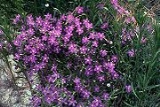
Sabatia campestris
Encyclopedia
Sabatia campestris is a species of Sabatia
, native to the south-central United States
, from Texas
east to Mississippi
and north to Iowa
and Illinois
. It is also locally naturalized
in New England
.
It is an annual plant
growing to 15–25 cm tall with pairs of opposite leaves
8–40 mm long and 5–20 mm wide. The flower
s are produced in open, long-stalked cymes at the top of the stems; the flower corolla is about 40 mm diameter, with five pink (rarely white) lobes with bluntly acute apices, and a contrasting bright yellow central 'eye'; they are hermaphrodite (contain both male and female organs). The fruit
is a capsule
containing numerous small seeds.
in gardens, where it requires moist soil and partial to full sun.
It can be used for medical purposes as an anti-periodic and tonic. It is also possible to obtain a herbal tea from the plant.
Sabatia
Sabatia is a genus of about 20 species of flowering plants in the family Gentianaceae, native to eastern and central North America , Central America, and the Caribbean....
, native to the south-central United States
United States
The United States of America is a federal constitutional republic comprising fifty states and a federal district...
, from Texas
Texas
Texas is the second largest U.S. state by both area and population, and the largest state by area in the contiguous United States.The name, based on the Caddo word "Tejas" meaning "friends" or "allies", was applied by the Spanish to the Caddo themselves and to the region of their settlement in...
east to Mississippi
Mississippi
Mississippi is a U.S. state located in the Southern United States. Jackson is the state capital and largest city. The name of the state derives from the Mississippi River, which flows along its western boundary, whose name comes from the Ojibwe word misi-ziibi...
and north to Iowa
Iowa
Iowa is a state located in the Midwestern United States, an area often referred to as the "American Heartland". It derives its name from the Ioway people, one of the many American Indian tribes that occupied the state at the time of European exploration. Iowa was a part of the French colony of New...
and Illinois
Illinois
Illinois is the fifth-most populous state of the United States of America, and is often noted for being a microcosm of the entire country. With Chicago in the northeast, small industrial cities and great agricultural productivity in central and northern Illinois, and natural resources like coal,...
. It is also locally naturalized
Naturalisation (biology)
In biology, naturalisation is any process by which a non-native organism spreads into the wild and its reproduction is sufficient to maintain its population. Such populations are said to be naturalised....
in New England
New England
New England is a region in the northeastern corner of the United States consisting of the six states of Maine, New Hampshire, Vermont, Massachusetts, Rhode Island, and Connecticut...
.
It is an annual plant
Annual plant
An annual plant is a plant that usually germinates, flowers, and dies in a year or season. True annuals will only live longer than a year if they are prevented from setting seed...
growing to 15–25 cm tall with pairs of opposite leaves
Leaf
A leaf is an organ of a vascular plant, as defined in botanical terms, and in particular in plant morphology. Foliage is a mass noun that refers to leaves as a feature of plants....
8–40 mm long and 5–20 mm wide. The flower
Flower
A flower, sometimes known as a bloom or blossom, is the reproductive structure found in flowering plants . The biological function of a flower is to effect reproduction, usually by providing a mechanism for the union of sperm with eggs...
s are produced in open, long-stalked cymes at the top of the stems; the flower corolla is about 40 mm diameter, with five pink (rarely white) lobes with bluntly acute apices, and a contrasting bright yellow central 'eye'; they are hermaphrodite (contain both male and female organs). The fruit
Fruit
In broad terms, a fruit is a structure of a plant that contains its seeds.The term has different meanings dependent on context. In non-technical usage, such as food preparation, fruit normally means the fleshy seed-associated structures of certain plants that are sweet and edible in the raw state,...
is a capsule
Capsule (fruit)
In botany a capsule is a type of simple, dry fruit produced by many species of flowering plants. A capsule is a structure composed of two or more carpels that in most cases is dehiscent, i.e. at maturity, it splits apart to release the seeds within. A few capsules are indehiscent, for example...
containing numerous small seeds.
Habitat
Its natural habitats are mainly fields, prairies (hence the name Priarie rose-gentian), open ground, woods and roadside edges.Cultivation and uses
Sabatia campestris is cultivated as an ornamental plantOrnamental plant
Ornamental plants are plants that are grown for decorative purposes in gardens and landscape design projects, as house plants, for cut flowers and specimen display...
in gardens, where it requires moist soil and partial to full sun.
It can be used for medical purposes as an anti-periodic and tonic. It is also possible to obtain a herbal tea from the plant.

